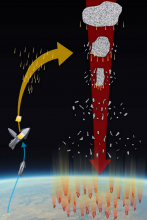Listen to today's episode of StarDate on the web the same day it airs in high-quality streaming audio without any extra ads or announcements. Choose a $8 one-month pass, or listen every day for a year for just $30.
You are here
End of the World
On a fine spring day 66 million years ago, the world came to an end. An asteroid the size of a city slammed into the Gulf of Mexico, gouging a giant crater. The impact blasted debris high into the sky, started fires thousands of miles away, and created a giant tsunami. That set off a chain reaction that killed the dinosaurs and most of the other life on Earth.
Scientists have learned a great deal about the event in recent years. One study, for example, looked at fossil-bearing rocks in North Dakota. From that, researchers concluded that the impact took place in spring.
Other studies have examined the crater. Known as Chicxulub, it’s off the Yucatan peninsula. It’s almost a hundred miles across and a dozen miles deep.
One study mapped what happened in the first day after the impact. Within minutes, flowing rock formed a ring of hills around the impact site; the hills were quickly buried by falling debris. An hour after impact, ocean water began filling the crater, bringing more debris. And in less than a day, the “rebound” of the tsunami hit the crater, depositing material from distant lands, including charcoal — evidence of a massive fire.
That was only the beginning of the end, though. Smoke from the fires blocked out the Sun for months or years around the globe. That snuffed out photosynthesis, which led to a collapse of the ecosystem. Within years, much of the life on Earth was gone — victims of a cosmic impact.
More tomorrow.
Script by Damond Benningfield






